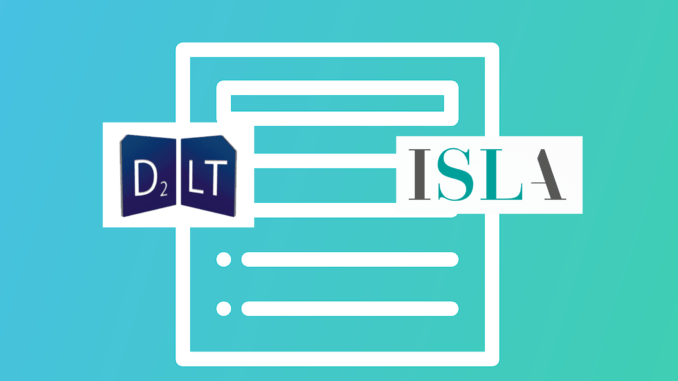
In another example of the growing movement toward standardisation in the legal sector, the International Securities Lending Association’s (ISLA) efforts to develop a clause library with shared data standards have reached a new milestone, significantly helped by legal tech company D2LT.
As Akber Datoo, CEO, D2LT, (see interview below), explained to Artificial Lawyer: ‘A proof of concept was successfully run in Q4 of 2020, focusing on seven of the clauses contained in the GMSLA (Global Master Securities Lending Agreement). D2LT and ISLA will now be completing the clause taxonomy and library during 2021.’
The move to set shared standards is reminiscent of the work being done at ISDA, the derivatives group, (see video about ISDA Create and Linklaters/Nakhoda). And in fact Datoo has worked with ISDA as well.
In terms of what is happening elsewhere, we have the work of the SALI Alliance, which is building a universal matter taxonomy for legal work. The focus there is more about building and sharing a way of classifying the work that lawyers do, so that producers and buyers of legal work are all operating from the same menu. But, it all contributes to the standardisation movement.
And most recently we have seen the oneNDA project launch, which is seeking to build an NDA standard template for use across the legal sector. And there are other organisations, such as the Loan Market Association, which are also developing contract standards.
Why does this matter? It matters because in a world of increasing legal complexity, twinned with a need for greater efficiency in legal services, standardisation across a variety of pathways is going to be essential. Clearly not for absolutely all work, that would be unlikely, but at least where standards make sense and can have a good fit.
Or, as ISLA puts it: ‘[We live] in an increasingly data-driven world, and firms are moving to operationalise their business through automating data-driven processes, allowing greater efficiency, scalability, and resilience through the medium of data. Key to this is the representation of contractual terms and the expression of business outcomes that they represent in a manner which follows a consistent, predictable and structured data format.’
This in turn makes the application of tech tools, whether NLP ‘after the fact’ analysis, or super-structured contract tools that extract key data at the point of creation – or most likely both – more effective. It could also make the use of smart contracts, i.e. self-executing agreements, more likely in this field.
The success of ISLA’s efforts is now marked by the launch of a white paper – which you can download here.
Andrew Dyson, CEO, ISLA, commented: ‘The work we are doing with D2LT sits at the heart of our digital agenda. This latest white paper puts this work in perspective, and sets a clear direction of travel for the industry as we look to maximise the use of this technology for our membership and wider industry stakeholder communities.’
Artificial Lawyer decided to find out some more about the initiative and spoke to Datoo (pictured) at D2LT in more detail about what is happening.

– What stage is ISLA and the standardisation project at now?
A proof of concept was successfully run in Q4 of 2020, focusing on seven of the clauses contained in the GMSLA. There was great industry engagement for this work, validated by ISLA’s legal survey at the end of 2020, where members confirmed that completing this work for the entirety of the GMSLA was a priority for them. Based on this, D2LT and ISLA are completing the clause taxonomy and library during 2021.
– Please tell us more about the part you played in ISLA reaching this stage of development with their standards.
D2LT guided ISLA through the importance of the clause taxonomy and library, helping them to appreciate the foundational role these play in terms of automation more generally in the securities lending industry. In particular, they are the precursor to document generation tools, negotiation platforms and AI/NLP tools to extract valuable insights from legacy documentation portfolios and data analytics more broadly.
In due course, they also facilitate the use of smart contracts to automate the performance of financial agreements such as the Global Master Securities Lending Agreement (GMSLA). Through our discussions, ISLA were very quick to appreciate that attempting these technology solutions without the right legal agreement standards that the clause taxonomy and library brings would be inefficient and limit the business value that Legal Tech can bring to its membership, if not developed.
– How broadly are these standards accepted now?
Membership engagement, across lenders, agent lenders, borrowers and banks, insurance companies and corporates has been impressive; and is increasing each week. It is a little early for market participants to incorporate the standards into their template, given we have not yet reached a critical mass of clauses.
However, we see many positive signs of that (it is the main reason for member engagement, to create a useable standard that will enhance resource optimisation, regulatory reporting, operational management – and make the whole process of negotiating and executing documentation far more efficient, through the ability to use a common means of referring to the business outcomes of the wording).
– Why is it important to have standards, and do you see a parallel with what ISDA is doing?
Standards play a vital role in building focus, cohesion and critical mass in the emerging stages of new technologies and business processes, codifying a ‘diffuse state of the art’ and creating a better sense of best practice.
Without a common language through which to refer to particular clauses and business outcomes of clauses found in legal contracts, the promise and hope of Legal Tech has not yet delivered its promised business value. Miscommunication between lawyers and operations – between what is meant by the data representation of a clause and its therefore system interpretation – have led to some feeling the technology is not yet ready.
There are huge parallels with the Clause Taxonomy and Library we have worked with ISDA on since 2018 – in fact, that ISDA work led to our discussions to undertake this work with ISLA. It has been great to see the value placed on harmonisation across the ISLA and ISDA efforts, with strong participation from ISDA with the ISLA initiative to align the clause taxonomy across the ISDA Master Agreement and the ISLA GMSLA.
This of course ties in with the ‘Digital Future for Financial Markets’ letter of July 2020. In this, eight leading trade associations, including ISDA and ISLA, asserted a joint commitment to defining and promoting the development of a digital future for financial markets. This is underpinned through common approaches and consistency across initiatives such as the Clause Taxonomy and Library.
—
Thanks Akber and good luck to you and ISLA with the project!